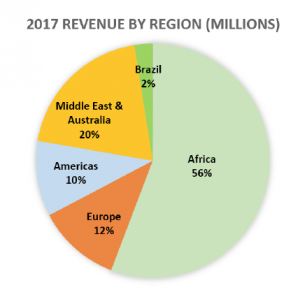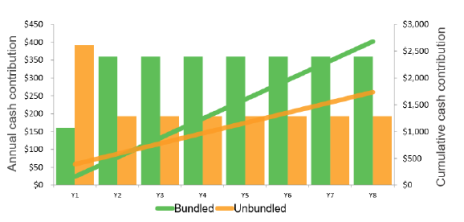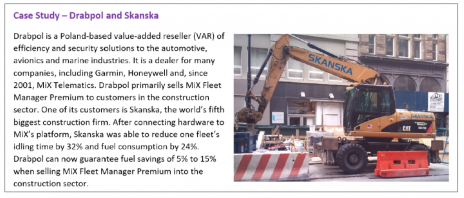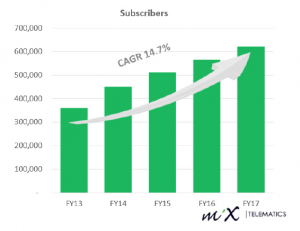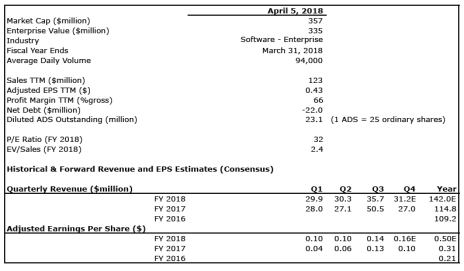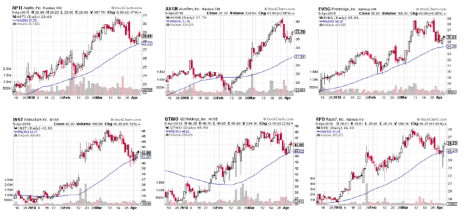There are roughly 200 million commercial vehicles in the world. They’re all trying to get to the right place, at the right time, at the lowest possible cost, without crashing. Managing these fleets probably isn’t as stressful as being an air traffic controller, but it’s right up there!
To help get the job done, fleet managers are increasingly turning to fleet telematics solutions. This specialized hardware and software can improve driver safety records, reduce accidents and theft, and reduce operating costs. Dramatic increases in fleet efficiency boost an organization’s bottom line. The bigger the group is, the bigger the potential opportunity.
All the details are inside this month’s issue of Cabot Small-Cap Confidential. Enjoy!
Cabot Small Cap Confidential 227
[premium_html_toc post_id="147870"]
THE BIG IDEA
If you’ve spent much time in the United Kingdom you might be familiar with Reading Buses. The company has been transporting passengers in and around Berkshire, England and the greater London area for over a century. Its fleet of 180 brightly colored, single- and double-deck buses are easily recognized. Color coordination with routes makes it easier for people to make sure they get where they want to go.
Running a public transportation service at this scale is no small task. And doing so safely and efficiently is a constant challenge. That’s why Reading Buses spent the beginning of 2015 installing telematics hardware in their entire fleet and integrating the devices with a sophisticated software platform. When the system went live in April the company was able to tell exactly where all buses were, what they were doing and how drivers were performing.
Nine months later, Reading Buses reported that across its fleet harsh breaking was down 27%, harsh acceleration was reduced by 44%, overall fuel consumption dropped by 2% and at-risk drivers were easily identified and given extra training to help them reduce their risk profiles.
Reading Buses isn’t just some random company I decided to profile because it has pretty buses. The company is a customer of MiX Telematics Limited (MIXT), the small-cap company I’m recommending today.
The Reading Bus example shows how something as seemingly simple as getting on a yellow bus, which will take you on a yellow route on the map, is quite complex when you consider the technologies that make that bus show up and drop you off on time.
Reading’s initiative to increase safety while decreasing operating costs is just one of many similar initiatives that companies across the globe are implementing with the assistance of cloud-based telematics platforms.
These platforms rely on in-vehicle hardware devices, cellular and GPS networks, and software solutions to collect, analyze and distribute mission-critical information to large fleet managers, small operators and even consumers like you and me.
Some customers, mostly in developing regions, simply want to protect their vehicles from theft, recover them quickly if they are stolen and protect mobile workforces from the plethora of dangers they face out on the road. A prime example is South Africa, where vehicle theft rates are roughly three times as high as they are in the U.S.
In more developed regions, like the U.S. and Europe, mid-sized and enterprise fleet operators want more sophisticated fleet management solutions that can tell where vehicles are, how their drivers are performing and how efficiently their vehicles are being operated. With the right solutions these operators can reduce fuel consumption, lower accident rates and save time on deliveries, all of which can boost their organization’s bottom line.
Across the world, customers are employing fleet and mobile asset management solutions to better deal with regulations and/or qualify for insurance incentives by using vehicle tracking and driver behavior solutions. Regulations are too many to list and vary based on region, but the big ones include Hours of Service (HOS), Electronic Logging Device (ELD), International Fuel Tax Agreement (IFTA) in North America, remote Digital Tachograph (DTCO) download for Europe and Electronic Work Diaries (EWD) in Australia.
In all cases, the reliability and ubiquity of cloud computing, data storage, real-time information, reliable networks, IoT devices, mobile devices and intuitive, sophisticated software, available at a reasonable cost, is making life a heck of a lot easier.
For a little while longer small fleet operators might be able to get by with spreadsheets and manual processes. But probably not for long, especially if they wish to compete with operators that are enjoying the cost savings and operating efficiencies that come with robust fleet management solutions.
And why not upgrade? The opportunity for fleet operators is huge! Roughly 80% of trucking operating costs include fuel, oil, driver wages and benefits, repair and maintenance and insurance. All of these can be cut with the help of technology. Even reducing these costs by a percentage point or two can make a big difference.
For solution providers the market is extremely attractive. There are roughly 200 million commercial vehicles registered around the globe. Only around 15% of them utilize fleet management solutions, according to ABI Research. Conservatively speaking, if we assume an annual subscription cost per vehicle of $420, the annual market opportunity tops $80 billion! Toss in more than seven million non-commercial vehicles just in South Africa and the market potential gets even bigger.
MiX Telematics, the company supporting Reading Buses, is taking advantage of the opportunity, expanding around the globe, and growing its subscriber base. It’s also becoming more profitable and has upgraded its infrastructure to allow for more rapid development of innovative fleet management solutions.
It’s an interesting story with tremendous growth potential, which is why it’s this month’s Cabot Small-Cap Confidential candidate.
THE COMPANY/PRODUCT
MiX Telematics (MIXT) is a global provider of fleet management, driver safety and vehicle tracking solutions that are accessed via a Software-as-a-Service (SaaS) delivery model. The platform uses a network of in-vehicle hardware, cellular networks, GPS systems and cloud-based infrastructure to provide 24-hour access to data, reporting tools and real-time notifications.
The company’s products are used by consumers and small, medium and enterprise customers to help protect investments in commercial fleets, mobile assets and personal vehicles. These solutions can track asset locations and use, reduce fuel and other operating costs, improve fleet efficiency, improve regulatory compliance, promote driver safety, manage risk and reduce theft.
The $357 million market-cap company is based in Johannesburg, South Africa, where it was founded in 1996 with a consumer-facing solution. Over the years it has expanded organically and through acquisitions, including Omnibridge in 2007. Omnibridge had recently acquired the distribution rights for its Fleet Manager product range from Siemens VDO, as well as Siemens VDO’s UK-based fleet management and commercial vehicle outfitting businesses. MiX went on to acquire Tripmaster in the U.S., SafeDrive International (SDI) in Dubai and Perth and three other smaller companies.
Today, MiX has a global presence with over 664,000 subscribers spread across 120 countries and six continents. The company trades on the Johannesburg Stock Exchange (JSE), and has American Depositary Shares (ADS) that trade in the U.S.
The company has a reputation for software innovation, a focus on safety and security, and an ability to adapt solutions to fit a wide range of industries. The biggest share of customers come from the oil and gas sector, which represents more than 20% of revenue. But other industries are well represented too, including transportation and logistics, public transport, construction, mining, bus and coach and rental and leasing.
South Africa is still MiX’s largest market, accounting for 56% of 2017 revenue. But with 17 offices globally, including in the U.S., UK, Australia, UAE, Brazil, Thailand, Uganda and Romania, MiX is relatively diversified across the globe.
In some markets – such as South Africa, where vehicle theft rates are high – MiX serves many consumers and small fleet operators. These customers typically purchase simple and inexpensive subscriptions focused on vehicle monitoring, safety, security and driver performance.
Larger customers typically purchase subscriptions to premium, enterprise fleet management solutions that can be scaled up or down depending on the individual customers’ needs. Most of MiX Telematics’ revenue is derived from software sales (81%), with the rest coming from a mix of hardware sales, installation services and driver training. The company has a knack for consistently growing its subscriber base. Over the last five years its compound annual subscription growth rate has been almost 15%.
MiX has roughly 5,000 fleet operator customers, which collectively made up 73% of revenue in 2017. More than 700 of these fleet operators are large customers with over 50 vehicles; these customers make up 86% of total subscriptions. No single customer represented more than 5% of revenue (the 10 largest customers represented 24% of revenue).
MiX’s large customers are well-known companies such as Baker Hughes, Bechtel Corporation, BP, Chevron, DHL, G4S, Halliburton, Nestle, PepsiCo, Praxair, Scania, Schlumberger, Shell, Total and Weatherford.
Platform
MiX Telematics has a subscription-based platform, called MiX Lightning, that is scalable to suit the needs of a wide range of fleet and mobile asset management customers. The software is available on-demand, complete with over 100 standard reports. Premium web-based business intelligence, enhanced analytics and data visualization tools are also available for customers seeking more granular analysis.
In FY 2017 MiX began investing in infrastructure to migrate data from legacy data centers (where the company owned and maintained equipment) toward cloud-based infrastructure provided by Amazon Web Services (AWS). This transition makes the company more efficient, and facilitated the rollout of the new back-end platform. Because of MiX Lighting, the company has quickly developed new products to address market needs, drive subscriber growth and expand average revenue per user (ARPU). New product modules include Journey Management, Hours of Service and MiX Go. The transition to AWS should be complete in FY 2019.
Let’s talk about MiX’s main solutions.
MiX Fleet Manager
MiX Fleet Manager is the company’s premier commercial fleet management solution and can be used to manage everything from small vehicle fleets all the way up to large enterprise fleets. It is an interactive, web-based system that provides secure access to live and historical driver and vehicle data, including vehicle tracking, status information, operational costs, alerts and notifications.
Customers can select several premium, subscription-based apps that are supported and integrated with MiX Fleet Manager. For instance, Mix Insight Agility is a Microsoft Excel plug-in that allows customized reporting on key metrics, MyMiX is a driver performance platform that allows drivers to view their performance on their smartphones, MiX Vision is an on-road and in-vehicle video recording solution giving fleet managers the ability to review footage of driving behavior and events and MiX Hours of Service allows real-time monitoring and compliance of working hours in regulated markets (such as the U.S.).
MiX Fleet Manager Essential
MiX Fleet Manager Essential is designed for customers seeking a mid-range solution with vehicle and fleet tracking, location, driver event and status information, without all the bells and whistles of a full enterprise fleet management system.
Matrix
Matrix is MiX’s entry-level mobile asset management solution suite, designed for small fleets and consumers. The software was first introduced in 1996. The current version provides real-time and historical vehicle tracking and positioning, unauthorized vehicle use alerts, panic emergency response, crash alerts, driver behavior alerts, fuel tax logbooks and vehicle maintenance notifications.
Beam-e
Beam-e is an entry-level consumer solution for the South African market. It relies on a crowdsourced network that bypasses traditional cellular networks, instead communicating with other nearby devices that interface with MiX’s systems. It is used by rental car companies, consumers, and owners of high-value assets as a vehicle location, tracking and recovery solution. The company is considering expanding Beam-e into other regions.
MiX Tabs
MiX Tabs was introduced in FY 2017 and uses the Beam-e technology to keep track of non-vehicle, corporate assets including generators, light towers, storage tanks and pumps.
A Word about Hardware and Bundled Contracts
In addition to offering proprietary software, MiX offers modular, proprietary hardware devices that are designed to work seamlessly with its core subscription offerings. Three types of in-vehicle devices are available: one for enterprise fleet management, one for light fleet management and consumer vehicle management and one for entry-level vehicle and asset tracking/recovery.
Historically, MiX has sold hardware devices for a profit. But for several quarters the company has been working to grow its recurring subscription revenue base by offering fully bundled solutions, which do not require upfront hardware purchases. This strategy reduces the upfront investment required by customers and makes it easier for sales teams to convert leads into paying clients. The downside is that MiX covers the cost of the hardware, which has a negative impact on gross margins and earnings growth. This trend was a little challenging to see in FY 2017 because MiX had a large jump in hardware sales in Europe, which meant hardware revenue was essentially flat as compared to 2016. But in FY 2016 and FY 2015, hardware revenue was down 26% and 8.6%, respectively.
To help show how this strategy will drive higher revenue (a trend that’s beginning to show up now), management put together a chart illustrating annual cash contribution (bars, left margin scale) and cumulative lifetime cash contribution (lines, right margin scale) from a typical premium fleet subscriber in both a bundled (green bars/line) and unbundled (orange bars/line) scenario. As you can see, by year three the bundled deal (green line) contributes more cash. By the end of year eight the bundled deal has contributed 54% more cash at an 80% gross margin, which is five percentage points higher than an unbundled deal. As we follow this story we’ll hear management talk more about trends resulting from bundled solutions.
The Business Model
MiX Telematics generates most of its revenue (81% in 2017) from subscriptions, with the rest coming from in-vehicle devices. Because of the large mix of subscription revenue, the number of subscribers and the price per subscription drives revenue trends. These factors are influenced by variables such as fleet size, geographic region, hardware options and distribution channel (direct sales team, distributor or dealer). The company has direct sales teams in most markets that focus on multinational enterprise accounts. Most contracts are for three to five years, though in certain markets, such as South Africa, regulations allow customers to cancel at any time. Consumers typically pay monthly or yearly.
The Bottom Line
MiX’s fiscal year (FY) ends on March 31. So until it reports Q4 results for FY 2018 (estimated release date in late May), the most recent annual results we have are from FY 2017. In FY 2017 subscription revenue rose by 7% (to $92.4 million) and total revenue rose by 5% (to $114.8 million). Adjusted EPS per American Depositary Share (ADS) was $0.31. By market, 2017 revenue growth (on a constant currency basis) was fastest in Brazil (up 63%) due to a 40% increase in subscribers (mostly bundled deals). Europe was MiX’s second-fastest growth market (up 16%) due to a 7% increase in subscribers, followed by Africa (up 6%), the Americas (0.2%) and the Middle East and Australia (down 6%). With 56% of revenue coming from Africa, that continent represented the biggest driver of MiX’s overall results.
In FY 2018 revenue growth has been accelerating, and in Q3 (ended December 31) subscription revenue was up 21% (to $30.4 million), total revenue was up 10.2% (to $35.7 million) and net subscribers were up 10% (to over 664,000). Adjusted EBITDA (a measure of profitability before interest, taxes, depreciation and amortization) was up 30% to $9.3 million. Adjusted EBITDA margin has now improved from 21% a year ago to 26% in Q3 FY 2018, which is very much on track toward management’s long-term goal of over 30%. The bottom line in Q3 totaled $0.14 per share, an increase of one penny. MiX ended the quarter with no debt and $21.6 million in cash and cash equivalents.
On the Q3 earnings call, management increased guidance for FY 2018, saying it expects revenue to be up 10% (to $142 million), subscription revenue to be up 15.7% (to $120.2 million), adjusted EBITDA margin in a range of 24.6% to 25.2% and adjusted EPS per ADS of $0.48 to $0.52. At the midpoint of guidance, EPS growth would be 61%.
MiX pays a variable dividend that’s good for an annual yield of around 1.2%. In May 2017 the board approved a share repurchase program of up to $21.8 million. As of the end of December 2017, MiX had purchased and retired $1.5 million of its own stock.
RISK
Reliance on oil and gas industry: For the last three years MiX has generated over 20% of subscription revenue from customers in the oil and gas industry in the U.S., Middle East and Australasia region. These revenue streams will rise and fall based on the complex factors influencing energy prices.
Home base in South Africa and Rand as reporting currency: MiX is based in South Africa and uses the South African Rand as its reporting currency. That means reported results will reflect currency fluctuations, and deciphering the results takes extra work for U.S. investors. It also means the company is subject to International Financial Reporting Standards (IFRS), which differ from GAAP standards in some respects. While exchange rate fluctuations haven’t had a material effect at the operating profit level for the last three years, and American Depositary Shares do simplify investment for U.S. investors, the bottom line is that analyzing MiX’s results is more complex than it is for a company based in the U.S. All that said, management does provide results in U.S. dollars too, and has considered changing its reporting currency to the dollar.
Long sales cycle for enterprise solutions: Large enterprise fleet management solutions contracts are complex and can take some time for sales teams to close. This means both subscription and hardware revenue can fluctuate quarter to quarter based on the level and timing of closing these contracts, as well as rolling out services.
Reliance on hardware manufacturers, distributors and dealers and cellular network providers: MiX has two suppliers of its in-vehicle device, sells to consumers via distributers, enterprise fleet customers via dealers, and contracts with cellular network providers to transmit data from vehicles to data centers. It’s important that the company maintain good relationships with these partners. Should any relationship fall apart the company would need to find a suitable replacement or risk sales and/or a gap in service areas.
COMPETITION
The fleet telematics industry is competitive and fragmented across industries and geographies. MiX competes with providers of fleet and mobile asset management solutions ranging from small, regional providers to large multinationals. The company’s larger competitors include NavMan Wireless, Trimble Navigation (TRMB), CalAmp (CAMP), ORBCOMM (ORBC) and Omnitracs. Smaller regional competitors include Greenroad and Masternaut in Europe, Astrata in Middle East oil and gas sector, and Tracker, Cartrack, DigiCore and Netstar in the South African consumer and small fleet mobile asset management markets.
THE STOCK
Trading Volume: MIXT has a market cap of $357 million and trades an average of 94,000 shares daily. That means roughly $1.5 million worth of stock trades each day. Our subscriber group shouldn’t move this stock on most days. That said, trading volume can be thin on some days when under 50,000 shares trade. Heavy days will see north of 400,000 shares, and that’s happened four days in the last six months (all of them were around the Raymond James conference on March 7).
Historical Price: The company’s ADS began trading in late 2013 and trended down until early 2016. The shares then traded above their 50-day line until a four-month pullback in early 2017. Buyers stepped back in after Q4 results for FY 2017 were released on May 25, and for the most part the stock’s been above its 50-day line since. The biggest recent pullback was in January when the stock retreated from $13 to $11.50. But another solid quarterly report on February 1, followed by a wave of high-volume buying in early March after the Raymond James conference, have pushed MIXT up near $16.
Valuation and Projected Price Target: Shares of MIXT trade with a 2018 EV/Sales multiple of 2.4, using management’s guidance for revenue of $142 million. Shares could easily trade up to an EV/Sales multiple of 3.0, which implies almost 30% upside now (price target of $20.50). We’ll revisit valuation after the Q4 FY 2018 conference call, at which point we’ll see if 10% revenue growth over the coming year is feasible (implying FY 2019 revenue of $156 million). Based on that rough estimate, a FY 2019 EV/Sales ratio of 3.0 would yield a price target closer to $22.20, or roughly 40% above where shares are today.
Buy Range (next two months): My preferred buy range is between $14 and $17. That range extends down to the 50-day line (roughly 12% below where we are now), and up to the level where, based on the trend, shares can advance to before their next pullback.
The Next Event: Management should announce Q4 FY 2018 results around May 24.
MiX Telematics Limited (MIXT) Financials
MiX Telematics Limited (MIXT) |
UPDATES ON CURRENT RECOMMENDATIONS
Due to the nature of the stocks recommended, it is to your advantage not to share these recommendations.
Buy means accumulate shares at or around the current price.
Hold means just that; hold what you have. Don’t buy, or sell, shares.
Sell means the original reasons for buying the stock no longer apply, and I recommend exiting the position.
Sell a Half means it’s time to take partial profits. Sell half (or whatever portion feels right to you) to lock in a gain, and hold on to the rest until another ratings change is issued.
I don’t know if we’re looking down the barrel of a full-fledged trade war. My gut says probably not and that Trump’s negotiating style is just rougher around the edges than we’re used to coming out of the Oval Office. Global growth still looks strong based on recent trade and global Purchasing Managers’ Indexes (PMIs) data. And my admittedly limited expertise analyzing trade policy suggests our widening trade gap is mostly a reflection of U.S. consumers spending habits (more spending, less savings) and a rise in government borrowing.
The road to a smaller trade deficit (assuming that’s the end goal) is paved with higher savings rates, lower consumption rates and a decrease in borrowing from other countries. Not a trade war waged over soybeans, steel, airplanes, cars, medical equipment and TVs.
But, again, this isn’t my area of expertise. And my gut could easily be wrong.
What I do know is that revenue and earnings estimates have gone up, and stock prices have gone down. That means the forward price-to-earnings ratio for the S&P 600 Small Cap Index has plummeted from a high of almost 21 a few weeks ago to 17.4 today. (The S&P 500’s forward PE ratio has fallen like a rock as well, from roughly 18.5 to 16.3.)
If we assume the S&P 600 Small Cap Index can trade up to a forward PE of 20, that implies an index value of around 1,100, which is 15.5% above where small caps trade right now. And, not coincidentally, it’s also the upper range of the end-of-year target I suggested as reasonable in my 2018 Small Cap Outlook.
Should we all go out and buy stocks with reckless abandon because index valuations look a lot more attractive now than a month ago? Probably not, especially given that many stock charts look just awful right now.
But I’m not at all opposed to picking up shares of stocks with strong fundamentals, good stories and great charts. And this describes many that are in our current portfolio, as well as MiX Telematics (MIXT), the stock I just profiled for this month.
To highlight six examples, check out this image of a six-pack of stock charts from our portfolio.
Apptio (APTI), AxoGen (AXGN), Everbridge (EVBG), Instructure (INST), Q2 Holdings (QTWO), and Rapid7 (RPD) are all great growth stocks, with great stories and nice charts. Shares of all six have held up around their 50-day moving average lines during the market’s recent turbulence. And that suggests they are poised for either a short-term bounce, or a larger leg up if this market gets going again. They should also be reasonably protected should a larger downside move occur. On the other hand, if most of these resilient stocks break well below their 50-day lines, then we’ll know the market is really deteriorating.
Some of these stocks were rated buy last week, and some that were rated hold. Today, they are all rated buy.
It is a slightly aggressive call to jump into six stocks with big positions, so if you’re game for buying, take it slow. I’m not calling for a big market rally (or even a small one) in the near-term. I’m simply pointing out that these stocks are standout performers and demand for shares appears to be relatively high. That means it’s worth owning some shares of at least a few of them!
Updates
AppFolio (APPF) shares are exactly where they were at the beginning of December, and don’t look like they’re going to break out of their $39 to $42 trading zone in the near-term. That said, the property management software vendor should grow revenue and EPS by 26% and 16%, respectively, this year. I like the stock and think there’s enough upside potential here to hold on, and eventually move back to Buy if it gets moving again. HOLD.
Apptio (APTI) develops Technology Business Management (TBM) solutions, which are an IT department’s software equivalent to finance’s ERP platform, human resources’ HRM platform and sales’ CRM platform. Customers are large, global organizations across all industries, and the company’s average annual subscription contract is for around $400,000. Apptio has also been introducing less expensive software solutions for smaller companies which has been helping drive another wave of growth (estimated 2018 revenue growth is 18%). With a boatload of cash from a recent convertible debt offering totaling roughly $230 million, Apptio looks poised to make a sizable acquisition this year. The stock recently held above its 50-day line. Keeping at Buy. BUY.
Arena Pharmaceuticals (ARNA) has been volatile lately and the stock has recently dipped below the $41.50 price that a secondary offering was completed at (and which raised gross proceeds of around $400 million). We’ve received updates on the company’s lead assets lately (ralinepag and etrasimod), both of which are moving into Phase 3 trials. The next asset on deck with a major update is APD371, which is being developed for treatment of abdominal pain in patients with Crohn’s disease. Arena’s management said there are currently no non-opioid drugs developed for visceral pain (inflammatory bowel disease (IBD), pancreatitis, etc.), and that the high selectivity of APD371 might both decrease off-target activity, while proving effective for treating visceral pain. Very little value has been assigned to APD371, but that could change depending on Phase 2 data, which is expected by the end of June. Continue to average in. BUY.
Asure Software (ASUR) was moved to sell a couple of weeks ago to lock in a 39% gain. SOLD.
AxoGen (AXGN) specializes in surgical solutions for peripheral nerve injuries. Think of damage due to car accidents, gunshot wounds, power tool accidents and surgical mistakes. AxoGen’s solutions helps these patients heal by bridging gaps in severed nerves, repairing crushed and damaged nerves and wrapping and protect repaired nerves. It is also expanding into breast reconstruction and facial reconstruction. Shares dipped a little over the last couple of weeks, but given that the stock was a little overbought, a modest pullback is probably a good thing. AxoGen is expected to grow revenue by 40% this year and cut its EPS loss by around $0.04, to $-0.27. I’m moving back to Buy after a small pullback, just keep new positions small. BUY.
BioTelemetry (BEAT) was moved to sell in a Special Bulletin a couple weeks ago. SOLD.
Datawatch (DWCH) was also cut loose a couple of weeks ago. SOLD.
Everbridge (EVBG) sells software solutions that provide fast, automated communications services during life threatening situations and mission-critical business events. The software platform powers apps that help organizations and government entities keep people safe, and business running. This week it announced it completed the acquisition of UMS, a Norwegian company with 1,200 customers reaching over 500 people through national and municipal alert systems, mainly in northern Europe, Greece, India, Cambodia and Colombia. Analysts currently see revenue growth of around 35% this year and EPS of around $-0.24 (up $0.06 from 2017). But those figures will likely change a little as the impact of UMS becomes clearer. Shares have held above their 50-day line since early December. Moved back to Buy, just keep new positions small. BUY.
Instructure (INST) has developed an innovative and easy to use cloud-based learning management system for academic and corporate customers. The company’s applications are valued for their ability to enable frequent and candid interaction between instructors and learners, streamline workflow and allow creation and sharing of content, on all devices, from virtually anywhere. Like our other strong performers, Instructure held firm at its 50-day line through the recent market turbulence. The company announced this week that its Canvas platform for higher education and K-12 institutions is available in Canada. Analysts see 31% revenue growth this year. BUY.
LogMeIn (LOGM) is a pure-play provider of collaboration software and applications that allow people and devices to connect from anywhere in the world with an internet connection. With the acquisition of Citrix’s GoTo business last year, and communications provider Jive Communications closing just this week, LogMeIn is becoming a formidable presence in the collaboration software space. It would be an attractive target for many potential acquirers. Shares broke just below their 200-day line last week, but an initiation from Mizuho ($145 price target) should give investors an indication of the upside potential (roughly 27%). Keep Holding. HOLD.
Materialise (MTLS) was sold a couple of weeks ago. Along with BioTelmetry and Datawatch, Materialise will go back on my watch list. SOLD.
Q2 Holdings (QTWO) provides cloud-based virtual banking solutions to banks and credit unions. Its platform was designed to deliver a secure and consistent user experience across all channels (online, mobile, tablet, text) so that account holders like you and me will remain loyal to their financial institution. The company has an efficient SaaS business model, meaning that as more banks sign on and the user base grows, earnings growth far outpaces revenue growth. For example, revenue growth in 2015, 2016 and 2017 was 38%, 38% and 29%, respectively. But EPS growth in the same years was 18% (EPS loss of $0.37), 14% (EPS loss of $0.32) and 109% (EPS of $0.03).
Now that the company is profitable the fun really starts! Expected revenue growth in 2018 and 2019 is 21% and 23%, respectively, while expected earnings growth is 367% (EPS of $0.14) and 171% ($0.38). This type of growth profile in a SaaS stock doesn’t come cheap – shares currently trade with an EV/sales ratio of 6.2 based on 2019 expected revenue. But the market will (usually) pay up for efficient, cloud-based growth stories. And Q2 Holdings fits that description to a tee. This doesn’t mean the stock is immune to market gyrations, but it does help explain why I describe it as one of least risky stocks in our portfolio. Moving back to Buy, just keep new positions small. BUY.
Rapid7 (RPD) is a cybersecurity stock that’s on a mission to solve complex security and IT operations challenges with innovative solutions that are easy to set up and use. Customers use its cloud-based and on-premise software solutions to better understand, prioritize and address the threats facing their physical, virtual and cloud assets, including threats that arise from the actions of people within their own walls. Cybersecurity is at the top of the list of investments companies are committed to making these days (along with cloud computing and digital transformation) meaning it would be one of the last budgets to get cut, should the economy turn south. This doesn’t guarantee Rapid7 will make us a truckload of money, but it does feed into my bullish thesis, along with a number of other positive factors detailed in my report (released in the beginning of March). The stock dipped to its 50-day line this week but has found support. It’s still a buy in my book. In 2018 we’re expecting revenue growth of around 20% and annualized recurring revenue (ARR) growth of around 30%. BUY.
Please email me at tyler@cabotwealth.com with any questions or comments about any of our stocks, or anything else on your mind.
Next Cabot Small-Cap Confidential issue is scheduled for May 4, 2018
Cabot Small-Cap Confidential is published by the Cabot Wealth Network, an independent publisher of investment advice. Neither the corporation nor its employees are compensated in any way by the companies whose stocks we recommend. Sources of information are believed to be reliable, but they are in no way guaranteed to be complete or without error. Recommendations, opinions or suggestions are given with the understanding that subscribers acting on information assume all risks involved. Copyright © 2018 - COPYING AND/OR ELECTRONIC TRANSMISSION OF THIS NEWSLETTER IS A VIOLATION OF THE U.S. COPYRIGHT LAW. For the protection of our subscribers, if copyright laws are violated by any subscriber, the subscription will be terminated.
[premium_html_footer]




